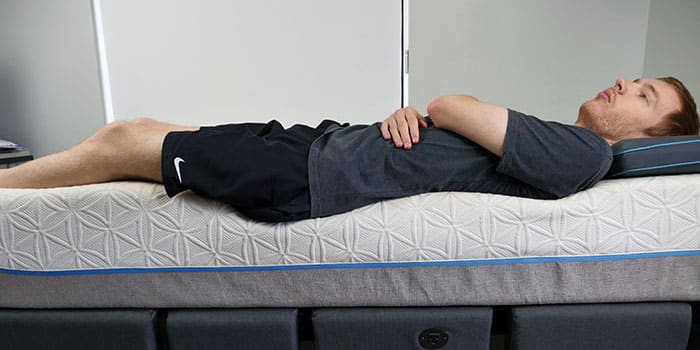
Best For
- Classic memory foam feel (high contouring, high pressure relief)
- Low motion transfer and low bounce
Considerations
- Tends to have worse cooling
- Higher price tag compared to most others
Our Verdict
Tempurpedic is a maker of high-end memory foam and hybrid mattresses. Over the years Tempurpedic has refined its memory foam material to be faster responding and cooler. While it is absolutely cooler than more traditional memory foam, it will still sleep warmer than many coil, latex, and poly foam mattresses.
Even so, Tempurpedic mattresses have low motion transfer, low bounce, moderate sinkage, and moderate response. When it comes to material quality, comfort, and support, there is basically nothing to complain about. Tempurpedic mattresses by any definition are amazing. The only significant con is the price.
Type: Memory Foam
Firmness: Medium (5)
In This Review
Performance Tests | Firmness | Support & Sleeping Positions | Design | Materials | Comparisons | FAQs
The Tempurpedic line of mattresses includes 5 main models with varying feels, firmnesses, and other features.
Read below for a full rundown of a Tempurpedic mattress review—the Cloud Breeze. We purchased this mattress in 2016 and have tested it on and off for the last five years. In recent years this mattress was renamed the Tempur Breeze.
Performance Tests
Here at NapLab, we put each mattress to the test.
We test 10 different factors that impact the comfort and feel of the mattress. Testing categories include:
| Test | Rating |
|---|---|
| Cooling | Very Good |
| Sinkage | Very Minimal |
| Motion Transfer | Extremely Low |
| Response Time | Very Fast |
| Bounce | Very Low |
| Edge Support | Good |
| Sex | Good |
| Pressure Relief | Exceptional |
| Off-Gassing | Excellent |
| Company | Very Good |
Cooling Test
The Tempurpedic mattress started with a temperature of 80.8° F. After lying on the mattress for 15 minutes the temperature peaked at a temperature of 96.5° F. After 5 minutes with no one lying on the mattress it had reduced the temperature back to 90.6° F.
Baseline Temp.
80.0° F
Max. Temp.
96.5° F
Ending Temp.
90.6° F
Max. Temp.
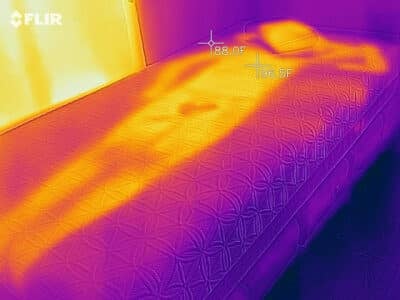
Ending Temp.

- Baseline Temperature – the temperature of the mattress before anyone lies on it
- Maximum Temperature (0 minute) – the temperature of the mattress after lying on it for 15 minutes
- Ending Temperature (5 minute) – the temperature of the mattress after being lied upon and having no one on it for 5 minutes
The Tempurpedic mattress is on the higher-end in terms of heat retention of the mattress we’ve tested thus far. However, compared to more traditional memory foam, it’s still going to be higher performance.
Heat Dissipation Over Time
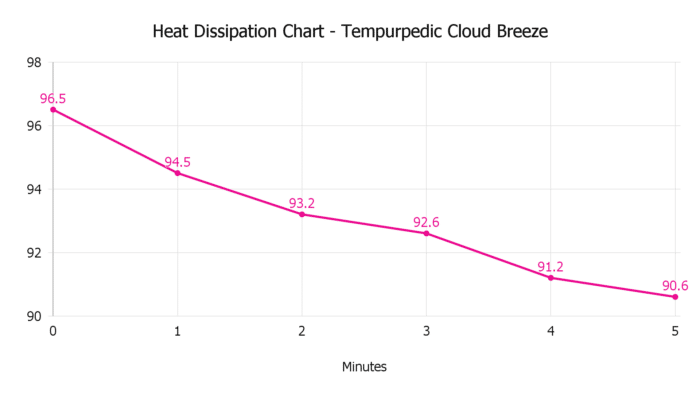
Where the Tempurpedic Cloud Breeze and other Tempurpedic mattresses that include the Breeze cover excel is the feel of the cover itself. The cover contains special fibers and cooling properties that help provide a cooler feel. Think if it as the cool side of the pillow.
As a result, when you first lie down it’s notably cooler, but over time it will lose that immediate cool-to-the-touch feel.
The foam materials and material construction help prevent some level of heat retention compared to traditional memory foam. Even so, it’s not a miracle worker. Compared to non-memory foam mattresses, hybrids, poly foam mattresses, and coil mattresses, the Tempurpedic (even with a Breeze cover) is going to sleep warmer than many other mattresses.
Sinkage Test
The results of this test showed that the Tempurpedic mattress has a very minimal level of sinkage.
Our pressure point sinkage test measured a maximum sinkage depth of 1.46″ using the 12-pound ball. This is significantly less sinkage than the average of 2.20″ (based on all of our tests to date).
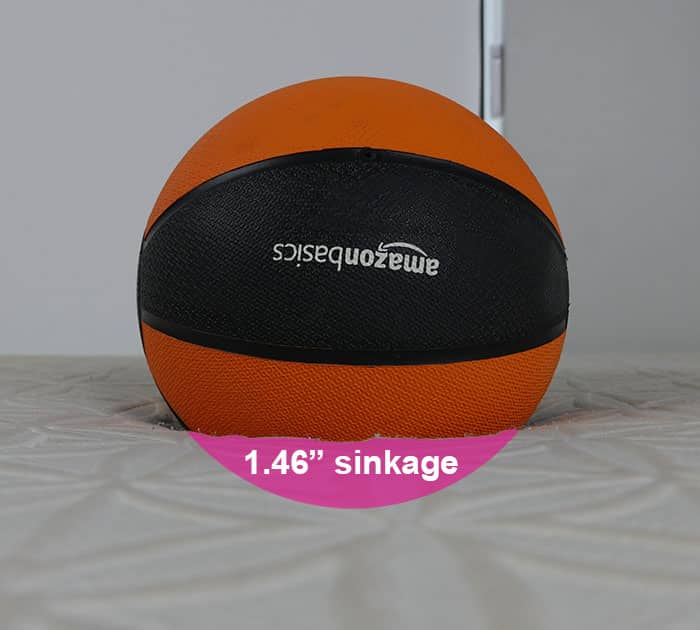
While the mattress does create a more exacting body contouring hug, it’s still somewhat restrained due to the minimal level of total sinkage depth.
Motion Transfer Test
The Tempurpedic has extremely low levels of motion transfer. In our motion transfer tests, we measured a total acceleration range of 5.17 m/s².
Max. Acceleration
1.68 m/s²
Min. Acceleration
-3.49 m/s²
Accel. Range
5.17 m/s²
This is 2.70 m/s² acceleration less than the average of 7.87 m/s².
The level of motion transfer is documented in the video below.
The all foam design, convoluted foam layers, and memory foam comfort layers work together to rapidly absorb and dissipate motion.
The extremely low motion transfer makes Tempurpedic a great choice for couples.
In our motion transfer chart, which visualizes our accelerometer data, we can see the highest motion peaks from 0 to 0.19 seconds. Motion drops off dramatically immediately thereafter.
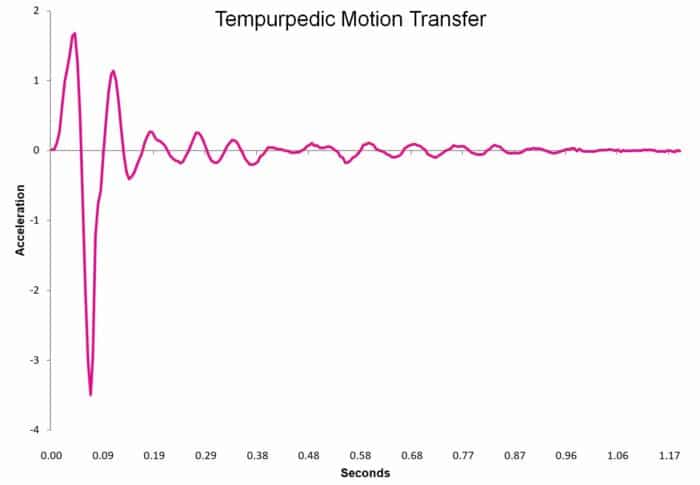
By 0.87 seconds motion has returned to near zero levels.
Response Test
Within 0.8 seconds, the Tempurpedic mattress mostly recovered back to its original shape. By 1.2 seconds the mattress had completely recovered.
Mostly Recovered
0.8 sec.
Complete Recovery
1.2 sec.
The level of responsiveness is documented in the video below.
This is a very fast recovery time, especially for memory foam. While hybrid or coil mattresses will typically be slightly faster, the difference is still fairly minor.
A common complaint among more traditional memory foam is that sleepers often feel “stuck” due to the slow response time. Tempurpedic’s proprietary memory foam material has a significantly faster response time compared to many other memory foams. As a result, sleepers are able to get a best of both worlds.
Bounce Test
In the case of Tempurpedic, the ball sank to a maximum depth of 4.84″ before rebounding upwards. Even though it did bounce up, it was just barely above the surface level of the mattress.
Max. Depth
4.84″
Max. Rebound
0.22″
Total Bounce
5.06″
The ball rebounded 0.22 inches above the surface level of the mattress.
The level of bounce is documented in the video below.
This level of bounce, or lack thereof as is the case, is not surprising for a memory foam mattress like this. Tempurpedic’s memory foam material absorbs a huge amount of energy.
Max. Sinkage Depth
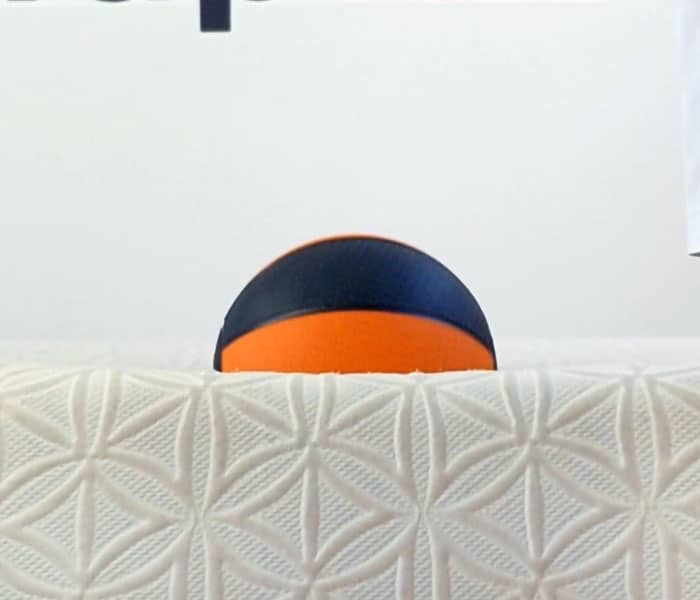
Max Bounce Height
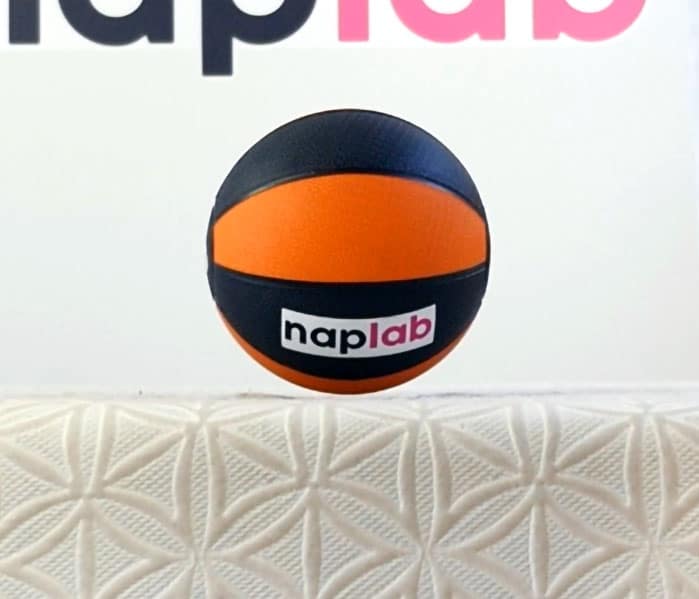
While this is beneficial for motion transfer, it does mean bounce is also minimized, which some sleepers may find unappealing, particularly as it relates to sex on the mattress.
Edge Support Test
Edge support on the Tempurpedic is less than great. In our sitting sinkage tests, we measured a total sitting sinkage of 6.0″. This is considerably deeper than the average sitting sinkage of 4.31″ (based on all of our tests to date).
Max. Sinkage
6.0″
Lying Support
Fair
Edge support while lying is equally as unimpressive. Whether or I was sitting or lying near the edge I did not feel well supported by the mattress.
The level of edge support while seated is documented in the images below.
Sitting, 140 lbs.
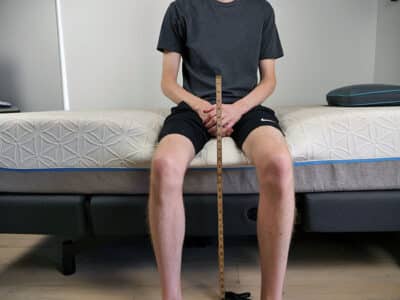
Sitting, 200 lbs.
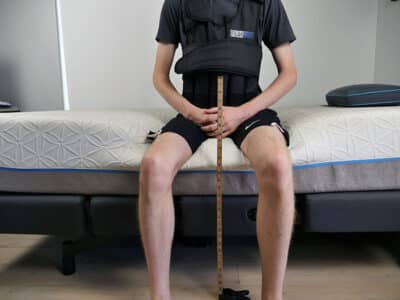
The level of edge support while lying is documented in the images below.
Lying on Edge, 140 lbs.
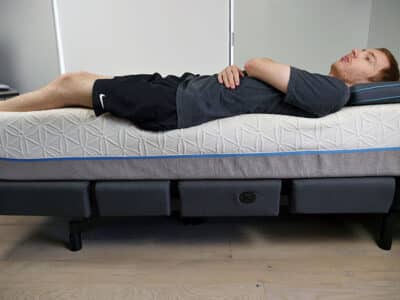
Lying on Edge, 200 lbs.
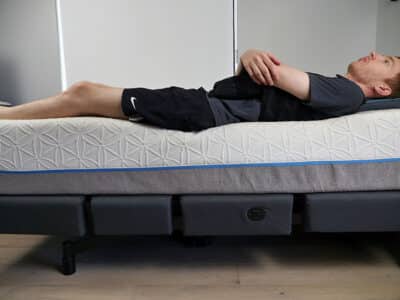
To be frank, 6.0″ of compression at the edge is a lot of sinkage. It’s not quite what I would call “full collapse”, but it’s close.
Soft and medium memory foam mattresses tend to struggle with edge support, as it’s difficult to find the balance between support along the edges, while still providing pressure relief, cooling, and contour that memory foam aims to achieve.
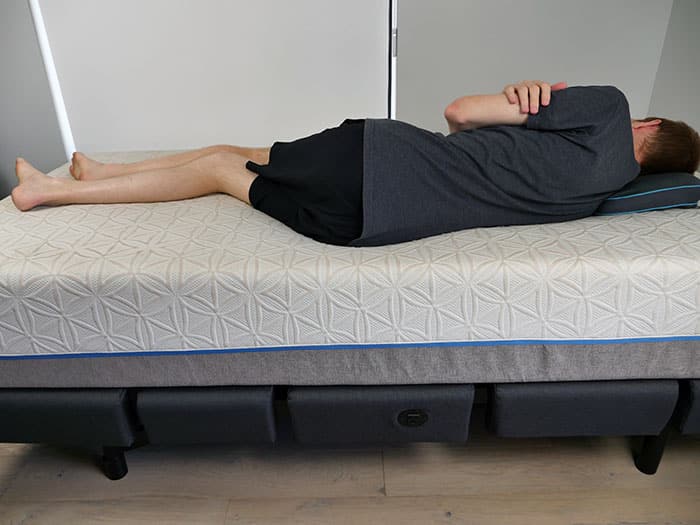
This lackluster edge support is driven in part via the Tempurpedic’s convoluted support foam layers. These layers help increase airflow and cooling, but what you gain in cooling you give up in support. Hence the more dramatic edge support.
Sex Test
The best mattresses for sex have high bounce, good edge support, quiet materials, and good pressure relief and cooling.
These 5 factors make up the NapLab sex performance score.
8.9Sex Test
For the Tempurpedic Cloud Breeze, these individual factors generated a sex score of 8.8.
The biggest thing that hurt the Tempurpedic score here was the foam.

It also retains more heat than some of the other mattresses we’ve tested, which negatively affects the cooling score.
I wouldn’t describe the Tempurpedic memory foam mattresses as “bad for sex”, but there are certainly significantly better options.
Pressure Relief Test
Great pressure relief is one of the biggest advantages of memory foam. It provides hug, contouring, and deep compression that can alleviate pressure points and stiff joints.
Comfort Layer
4.0″
Support Layer
7.5″
The 4″ comfort layer helps to provide this pressure relief, as it takes up 35% of the entire thickness of the mattress.
The relative softness of the various medium firmness models offered by Tempurpedic are excellent for side sleepers.
This is due to the contouring hug created by the memory foams, in combination with the medium feel. There should be no doubt, with respect to pressure relief, the Tempurpedic mattress is excellent.
Off-Gassing Test
The Tempurpedic mattress has a strong memory foam smell initially after it had arrived.
Initial Smell Strength
Moderate
Off-Gassing Period
3 days
However, the strength of the smell reduced quickly. By the end of the first day the intensity of the smell was minor.
By the end of 3 days the smell was essentially gone.
Company
The company score takes a look at factors that may influence your experience with the mattress.
Factors include length of the trial period, warranty, shipping / return costs, and country of origin.
| Company Factor | Factor Weight | Score | Data |
|---|---|---|---|
| Trial Period | 25% | 8 | 90 nights |
| Warranty | 25% | 10 | 10 years |
| Shipping | 25% | 10 | $0 |
| Returns | 25% | 8 | $175 |
| Country of Origin | USA |
The Tempurpedic brand has been around for almost 30 years and is a long-standing sign of memory foam luxury and high quality. During our review, we found that the product stands up to its name and it’s certainly high quality.
With more and more online mattresses hitting the market at competitive prices, the sticker shock of Tempurpedic mattresses is still on the high side, but for consumers looking for a company with a long track record of quality mattress production, it’s a solid option.
The trial period is a little shorter (relative to many online only mattress brands) and you’ll have to pay for return shipping, but you will be able to get your money back from the initial purchase.
Tempurpedic’s website says that they “typically” ship in 7-10 days, but due to high-demand shipping can take 3-5 weeks “depending on product selection”. They do not indicate what products take longer to ship. We are using the 3-5 weeks as our shipping score.
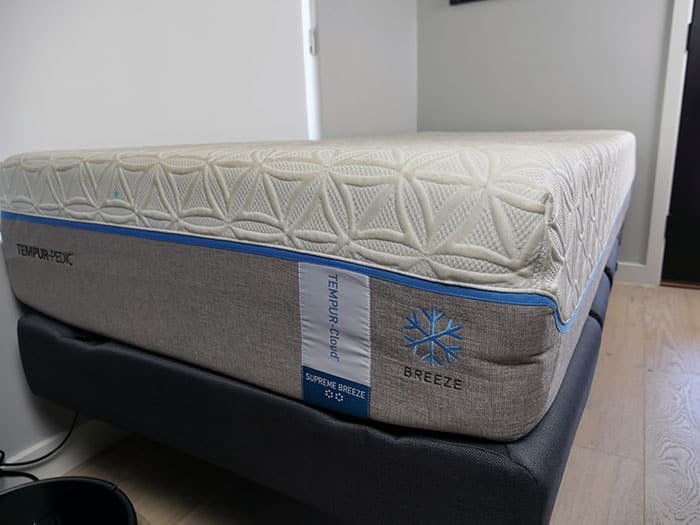
Outside of the 90-night trial, there is also a 10-year limited warranty. If you opt for a Tempurpedic mattress, be sure to read the details of the limited warranty so you understand the exceptions.
The type of base you use (or do not use) can affect the warranty, as well as indentations in the foam that fall within the standard range of acceptable wear.
How firm is Tempurpedic?
This is a bit of a loaded question, as Tempurpedic offers a pretty wide range of firmness levels. Of the five current models, there are three general firmness levels.
Soft
4 out of 10
Medium
5 out of 10
Firm
7 out of 10
In addition to the three levels, there are two mattress types that fall under the Medium category—Medium and Medium Hybrid.
The mattress we tested was the Cloud Breeze which is classified as a Medium. On our scale, it came in around a 5 out of 10, where 10 is the most firm.
Tempurpedic Firmness Comparison
Here is a detailed breakdown of the firmnesses that are available for each model.
| Model | Soft | Medium | Medium Hybrid | Firm |
|---|---|---|---|---|
| TEMPUR-Cloud | No | Yes | No | No |
| TEMPUR-Adapt | No | Yes | Yes | No |
| TEMPUR-ProAdapt | Yes | Yes | Yes | Yes |
| TEMPUR-LuxeAdapt | Yes | No | No | Yes |
| TEMPUR-Breeze | Yes | Yes | Yes | Yes |
Tempurpedic Soft Feel

The Tempurpedic Soft is around a 4 out of 10 on the firmness scale—noticeably softer than the medium and may lack sufficient edge support, depending on your needs. This firmness could be a good option for side sleepers of medium or lighter weights as well as petite back or stomach sleepers.
Tempurpedic Medium Feel

The Tempurpedic Medium is around a 5 out of 10 on the firmness scale—good middle-of-the-road firmness to suit a number of different sleeper weights, positions, and personal preferences.
NOTE: In this review, we personally tested the Cloud Breeze Medium.
Tempurpedic Medium Hybrid Feel

The Tempurpedic Medium Hybrid is around a 4.5 out of 10 on the firmness scale—just a touch softer than the Medium. The bounce of the coils on the Hybrid model allow this mattress to feel a bit softer, but it would still be a nice balanced option for a variety of sleeping types, bodies, and positions.
Tempurpedic Firm Feel

The Tempurpedic Firm is around a 7 out of 10 on the firmness scale—a touch firmer than the medium, but a good option if you have a heavier weight and sleep on your back or stomach.
Tempurpedic Medium vs. Medium Hybrid
The Medium and Medium Hybrid will be similar, but the Hybrid will be a bit softer in feel.
The biggest difference is that the Medium is made entirely of TEMPUR material, whereas the Medium Hybrid is made with TEMPUR-ES material, as well as 1000 tiny coils in the base layer.
This gives it a bit of extra bounce but still has that classic memory foam feel on the top. If you don’t like feeling “stuck” in a mattress or just want easier movement, the Hybrid is a nice option.
Support & Sleeping Positions
Depending on your body weight, sleeping position, and personal preference, you may find that one firmness level is more ideal than another.
To help pick the best firmness for your needs, we’ve put together the tables below. The following tables can help you find the right firmness options. Depending on your body weight and sleeping position, certain mattress firmnesses will be better / worse.
Tempurpedic Medium Mattresses
| Sleeper Weight | Stomach Sleepers | Side Sleepers | Back Sleepers |
|---|---|---|---|
| Under 150 lbs. | Yes | Yes | Yes |
| 150-250 lbs. | Yes | Yes | Yes |
| 250-300 lbs. | Maybe | Yes | Maybe |
Tempurpedic Medium Hybrid Mattresses
| Sleeper Weight | Stomach Sleeper | Side Sleeper | Back Sleeper |
|---|---|---|---|
| Under 150 lbs. | Yes | Yes | Yes |
| 150-225 lbs. | Maybe | Yes | Maybe |
| 225-300 lbs. | No | Maybe | No |
Tempurpedic Firm Mattresses
| Sleeper Weight | Stomach Sleepers | Side Sleepers | Back Sleepers |
|---|---|---|---|
| Under 150 lbs. | Yes | Maybe | Yes |
| 150-250 lbs. | Yes | Maybe | Yes |
| 250-300 lbs. | Yes | Yes | Yes |
Tempurpedic Soft Mattresses
| Sleeper Weight | Stomach Sleeper | Side Sleeper | Back Sleeper |
|---|---|---|---|
| Under 150 lbs. | Yes | Yes | Yes |
| 150-225 lbs. | Maybe | Yes | Maybe |
| 225-300 lbs. | No | Maybe | No |
Design
There are a number of different Tempurpedic mattress varieties on the market. The five most popular and flagship models are listed below.
The Models
TEMPUR-Adapt

TEMPUR-ProAdapt

TEMPUR-LuxeAdapt

TEMPUR-Breeze
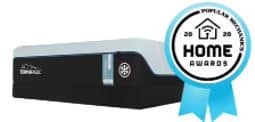
TEMPUR-Cloud
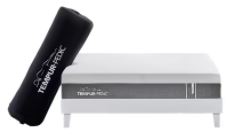
Of course, Tempurpedic has been making mattresses since the early 1990s, so there are many other models beyond this list, both current and discontinued.
Type
Memory Foam
Thickness
12″
Firmness
5
The model we tested for this review is the 2016 Tempurpedic Cloud Breeze. While this exactly model is no longer sold (at least that we could find), it’s substantially similar to the new TEMPUR-Breeze.
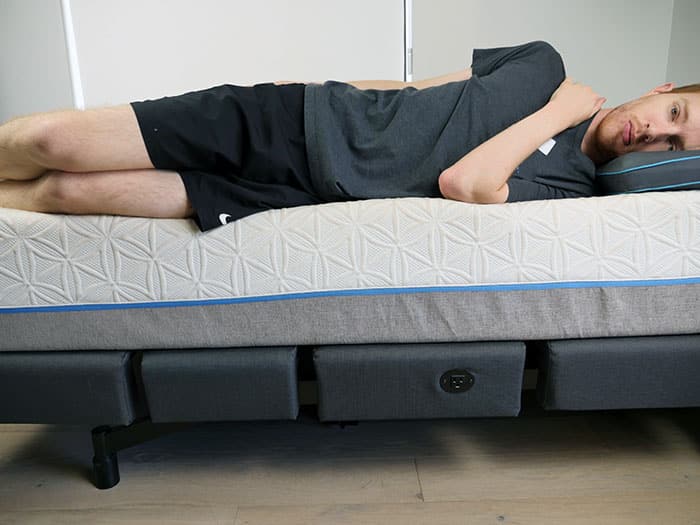
While Tempurpedic models and names change over the years, the material construction (at least in modern recent Tempurpedic history) is largely the same. They are fundamentally memory foam and hybrid mattresses with high-performance covers.
Materials
The Tempurpedic uses memory foams and denser support foams for a classic memory foam feel.
Corrugated support foams used on the base help to promote airflow and prevent the mattress from getting too hot.
The five main layers of the Tempurpedic include:
- 2.0″ memory foam
- 2.0″ memory foam
- 4.0″ support foam
- 3.5″ support foam
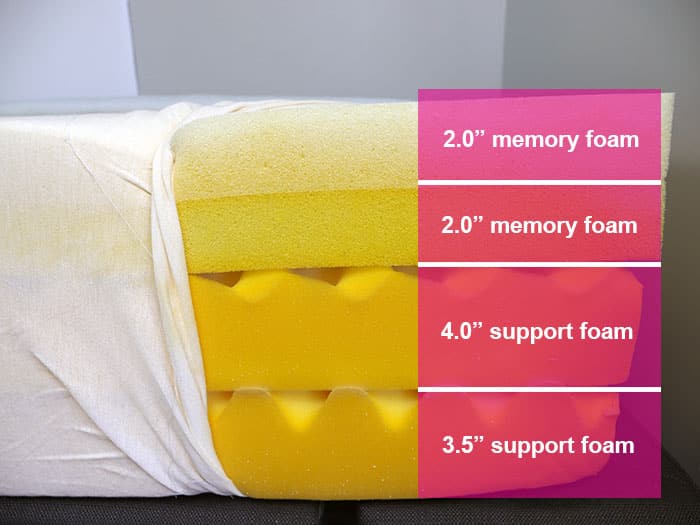
Why is the foam yellow?
I will add here that age has a tendency to “yellow” memory foam, and even high-dollar Tempurpedic mattresses are no exception to the rule.
This mattress is nearly 5 years old and the foam has yellowed a significant amount from when we first reviewed this mattress. Originally these foams were white / off-white.
That being said, most people would never see the condition of the interior foam unless you ripped through the cover, as we do to examine the foam layers.
The Cover
The top cover of most Tempurpedic mattresses is made of a stretchy, water-resistant textile.
There is a slight embossed texture that does tend to show wear and dirt as the mattress ages, but overall it’s comfortable and has a clean aesthetic.
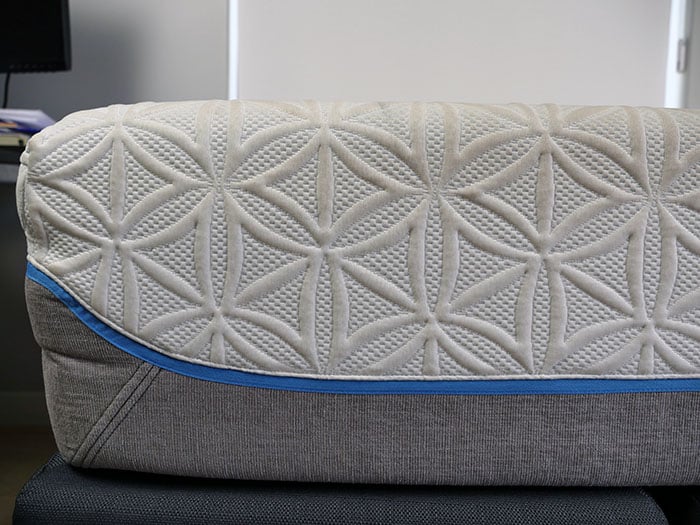
The sides of the Cloud Breeze mattress are dark gray with a thin blue accent trim. Exact design, materials, and color of each cover may vary depending on what model you go with.
The Comfort Layer
The comfort layer is made up of two seperate foams that sit atop the support layer.
The first layer is a comfort memory foam. It is 2″ thick and is the initial softness you feel when you lay on the mattress.
The second layer is also memory foam and 2″ thick. The PCF (pounds per cubic foot) density of this layer is slightly different, but these two layers work together to provide a balance of support and excellent pressure relief.
The Support Layer
The bottom layer is a combination of two corrugated foams with a higher density than the comfort foams. The firmness of these foams provides support and stability to the mattress.
Also, the corrugated design of these foams allows more air to pass through and promotes better airflow and cooling when you’re sleeping.
Product Evolution
Tempurpedic first started selling mattresses in 1992. The original Tempurpedic memory foams were more traditional by today’s modern standards.
They were extremely slow to respond, slept hot, had very little bounce, and created dramatic contour.
Over the years Tempurpedic has continued to refine its memory foam to most notably make it sleep less hot and respond more quickly.
The memory foam included in the 2016 Cloud Breeze that we tested, as well as today’s modern flagship lineup, would hardly be recognizable compared to Tempurpedic’s early models.
From year to year, the differences in foam design and construction are not dramatic. However, over the decades there has been a significant product evolution driven by incremental improvements to Tempurpedic’s proprietary foam formula. In addition, improvements by and the larger mattress / sleep / foam industries have aided Tempurpedic in their advancement of memory foam and hybrid mattress design.
How is Tempurpedic Different?
The Tempurpedic Cloud Breeze mattress has a lower overall score and a significantly higher price tag—3.5X the price of the average memory foam mattress we’ve tested to date.
Note: In all fairness, the Cloud Breese was released in 2016 and most of the mattresses that make up the average were manufactured by 2021 (or newer). Newer mattresses oftentimes produce higher scores thanks to advancements in technology, materials, and production practices.
| Factor | Tempurpedic Cloud Breeze | Average |
|---|---|---|
| Overall | 9.37 | 9.52 |
| Price | $4,599 | $1,291 (Memory Foam only) |
| Cooling | 9 | 9.4 |
| Max Sinkage | 1.46″ | 2.21″ |
| Total Motion Transfer | 5.17 m/s² | 7.97 m/s² |
| Response Time | 0.8 sec. | 0.4 sec. |
| Total Bounce | 5.06″ | 9.61″ |
| Edge Support – Sitting Sinkage | 6.00″ | 4.29″ |
| Mattress Thickness | 11.5″ | 11.9″ |
| Sex Overall | 8.9 | 9.6 |
| Comfort Material | 4.0″ | 4.1″ |
| Off-Gassing – Smell | Moderate | Strong |
| Off-Gassing – Days | 3 days | 4 days |
| Trial | 90 nights | 158 nights |
| Warranty | 10 years | 28% have lifetime warranties, average of other 72% of mattresses is 14 years |
Compared to the average, Tempurpedic has a bit warmer feel, but also has less sinkage than average so you avoid that stuck feeling.
The Cloud Breeze also has less motion transfer than average and less bounce as well.
The response is slower than average (thank you, memory foam) and edge support also struggles.
The lower level of bounce and struggling edge support makes this mattress not the best choice for good sex as well.
Other Mattresses to Consider
For Savings
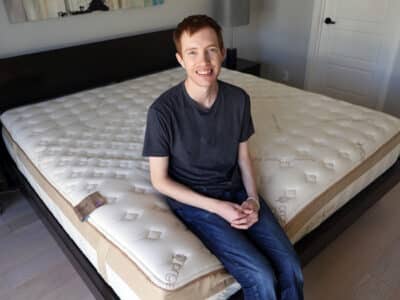
Loom & Leaf
Online Memory Foam
Loom & Leaf is sold exclusively online. However, it’s also notably less expensive than Tempurpedic, but shares most of the same performance and feel characteristics that Tempurpedic has.
For Cooling
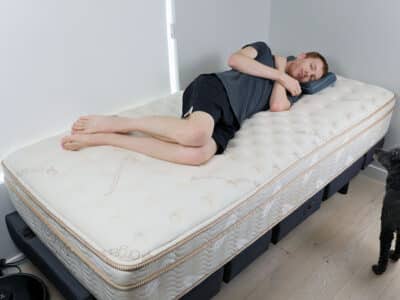
Saatva Classic
Improved Cooling
If you’re a warm sleeper you should consider a coil-on-coil mattress. Saatva’s Classic is notably cooler while providing excellent edge support, bounce, and response.
For Balance
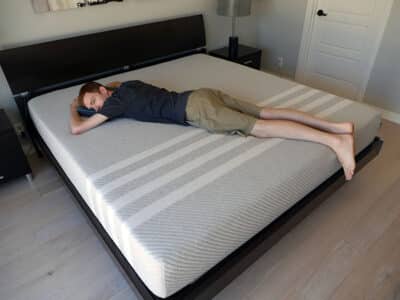
Leesa
Balanced Foam Combo
Leesa uses poly foam and memory foam to create a balance between high response and high contour. It provides a feel between 100% memory foam and 100% coils.
Frequently Asked Questions
Tempurpedic offers a wide lineup of mattress styles and sizes. They certainly fall on the upper tier of prices, but they also use high-quality materials and a good warranty program. You can spend anywhere between $1,400 – $5,000 for a queen-sized mattress.
Tempurpedic offers a 90-day trial period. If you decide that the mattress isn’t for you, you can return it, but the customer must pay return shipping.
Yes. There are many in-store locations to try out the Tempurpedic line.
Cleaning a Tempurpedic mattress is similar to how you would clean any other foam-based mattress. You can spot clean with cold water and mild detergent or vacuum the mattress. To avoid stains and spills altogether, consider adding a waterproof mattress pad or a 6-sided mattress encasement.




